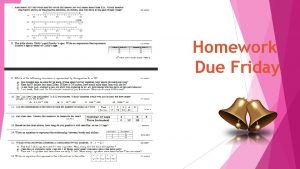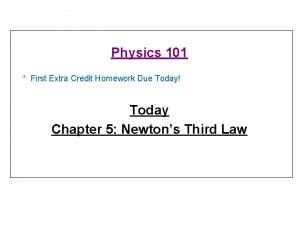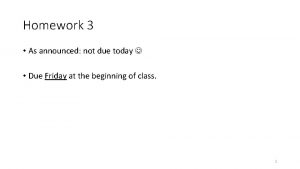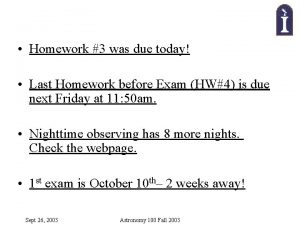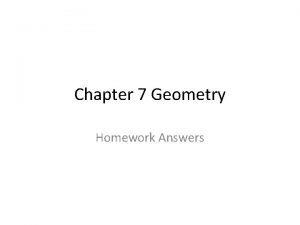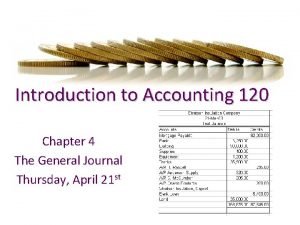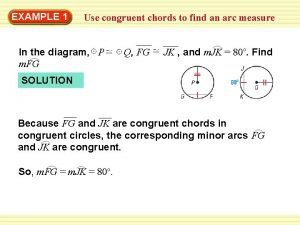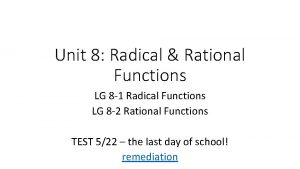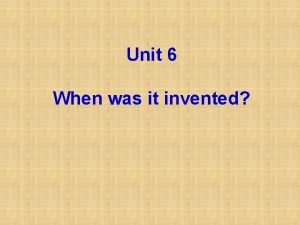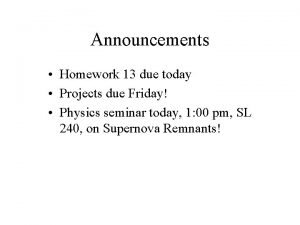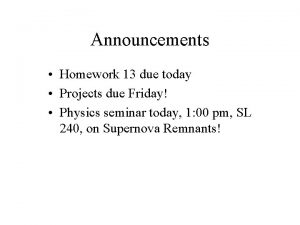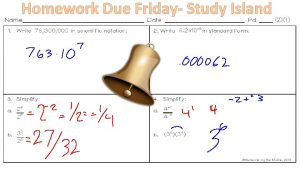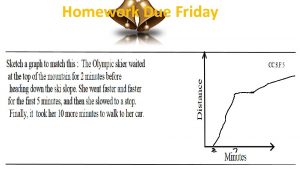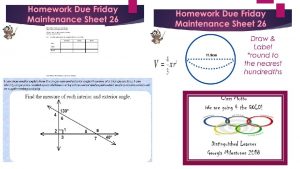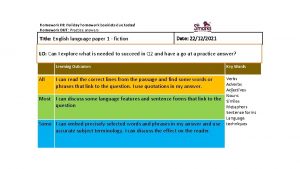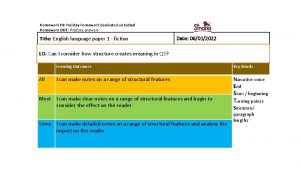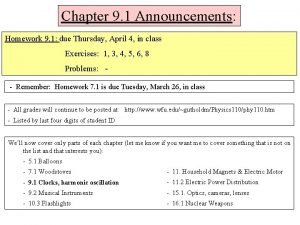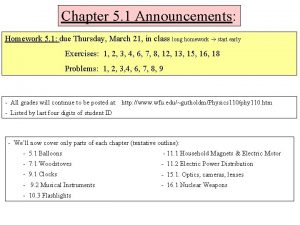Chapter 9 2 Announcements Homework 9 2 due


































- Slides: 34

Chapter 9. 2 Announcements: Homework 9. 2: due Thursday, April 11, in class Exercises: 9, 10, 11, 12, 14, 15, 16, 23, 24, 31, 32 Problems: 1, 2, 3, 4 - Remember: Homework 9. 1 is due Thursday, April 4 We’ll now cover only parts of each chapter (let me know if you want me to cover something that is not on the list and that interests you): - 5. 1 Balloons - 11. Household Magnets & Electric Motor - 7. 1 Woodstoves - 11. 2 Electric Power Distribution - 9. 1 Clocks, harmonic oscillation - 15. 1. Optics, cameras, lenses - 9. 2 Musical Instruments, waves - 16. 1 Nuclear Weapons - 10. 3 Flashlights

Chapter 9. 2 Musical Instruments (waves) Concepts Demos and Objects - waves in a room/stadium waves in a pipe a speaker (creating sound) ear tuning fork waves on a string wave modes (harmonics) - longitudinal waves transverse waves traveling & standing waves on a string waves in an air column ear and hearing wave length frequency/pitch sound

Traveling transverse waves Crest/bump travels Transverse waves: particle wave The particles of the disturbed medium move perpendicular to the wave motion

Traveling, longitudinal waves compression travels Longitudinal waves: The particles of the disturbed medium move parallel to the wave motion

Examples of waves (i-clicker-1): Which wave is a longitudinal wave? A. “Bump” traveling down a string: __________ B. Sound waves: __________ C. La ola in a stadium (getting up/sitting down): _______ D. Water wave: ______________

Basic Variables of Wave Motion Terminology to describe waves

Sound Waves Sound - is a wave (sound wave) - Rarefied and compressed regions of medium (e. g. , air) - Longitudinal wave - air molecules move back and forth

Sound Waves Sound waves are longitudinal waves. They consist of compressed and rarified regions of gas (medium) We can hear (audible) frequencies from about 20 Hz (low) to 15, 000 Hz (high). Infrasonic “sound” waves: below ~ 20 Hz Ultrasonic sound waves: above ~ 15, 000 Hz The speed of sound in air: c ~ 343 m/s ~ 740 mi/hr ~ 0. 2 mi/sec. (dry air, 68 F)

i-clicker-2 It is a dark and stormy night. Lightning strikes in the distance. You see the lighting, then, after ten seconds you hear the thunder. How far away did the lighting strike? A. 1 mile B. 2 miles C. 3 miles D. 4 miles E. 5 miles

Sound waves, hearing and the ear Short video about human hearing: https: //www. youtube. com/watch? v=qgdqp-o. Pb 1 Q

Notes and their fundamental frequency Octaves: frequency doubles for each tone

Creating standing waves: When two waves are traveling back and forth, under the right conditions (right frequency), we can create standing waves. Standing waves have stationary nodes and antinodes Examples we’ll talk about: - Standing waves on a string. - Standing waves in a pipe (open and closed).

String Harmonics L frequency 2 f 1 3 f 1 4 f 1 5 f 1 6 f 1 L … Length of string; T … Tension m … mass of string

Standing waves have stationary nodes and anti-nodes L … Length of string T … Tension (not period T) m … mass of string

Strings as Harmonic Oscillators • A string is a harmonic oscillator – Its mass gives it inertia – Its tension gives it a restoring force – It has a stable equilibrium – Restoring forces are proportional to displacement • Stiffness of restoring forces determined by – String’s curvature – String’s tension

Fundamental Vibration • String vibrates as a single arc, up and down – velocity antinode occurs at center of string • This is the fundamental vibrational mode • Pitch (frequency of vibration) is – proportional to – inversely proportional to string length – inversely proportional to

i-clicker-3 How can a violin player play a lower note: A. B. C. D. E. Increasing the tension in the string. Playing a string with less mass (thinner string). Shortening the string. A & C None of the above.

Overtone Vibrations • In addition, string can vibrate as – two half-strings – three third-strings – etc. • These are higher-order vibrational modes • These modes have higher pitches – overtones

Harmonics in a String • In a string, the overtone pitches are – two times the fundamental frequency (octave) – three times the fundamental frequency – etc. • These integer multiples are called harmonics • Bowing or plucking a string tends to excite a mixture of fundamental and harmonic vibrations, giving character to the sound

notes E 5 A 4 D 4 G 3 i-clicker-4: Why do all musical instruments have a body (wood body, metal shell, etc)? A. B. C. D. E. They look prettier They are easier to hold They act as resonators (amplify sound) They act as dampers (reduce sound) No good reason

Music and Resonance: Primary and secondary oscillators strings body Mouthpiece Air column String Instruments Wind Instruments

Connecting primary (strings) and secondary (body) oscillators

Producing Sound • Thin objects don’t project sound well – Air flows around objects – Compression and rarefaction is minimal • Surfaces project sound much better – Air can’t flow around surfaces easily – Compression and rarefaction is substantial • Many instruments use surfaces for sound

Violin Harmonics Viola Harmonics

Compare to Chladni plate demo

i-clicker-5: Why are some violins so expensive (Stradivarius : $ 1. 5 M)? Computer Tomography scan of a Nicolo Amati Violin (1654) A. B. C. D. E. Old stuff is always expensive. They are made of expensive materials. In fashion and music, you pay for the label. The secondary oscillator mixes a rich sound of harmonics. The primary oscillator produces unusual frequencies.

Primary Resonators: Wind Instruments Flute Woodwinds Brass Lips Fixed Edge Reed

Open pipe:

Fund. Frequency c… speed of sound c = 343 m/s in air

Half-closed pipe: Fundamental frequency:

i-clicker-6; 7: You play an open organ pipe with a length of 1 m. What is the fundamental frequency? A. B. C. D. E. 1 Hz 86 Hz 172 Hz 343 Hz 686 Hz Now you close the pipe at one end. What will the frequency be then? A. B. C. D. E. 1 Hz 86 Hz 172 Hz 343 Hz 686 Hz

Air as a Harmonic Oscillator • A column of air is a harmonic oscillator – Its mass gives it inertia – Pressure gives it a restoring force – It has a stable equilibrium – Restoring forces are proportional to displacement • Stiffness of restoring forces determined by – pressure gradient

Fundamental Vibration • Air column vibrates as a single object – Pressure antinode occurs at center of open column – Velocity antinode occurs at ends of open column • Pitch (frequency of vibration) is – inversely proportional to column length – inversely proportional to air density • A closed pipe vibrates as half an open column – pressure antinode occurs at sealed end – Velocity node occurs at the sealed end – frequency is half that of an open pipe

Harmonic Vibrations • In addition, column of air can vibrate as – two half-columns – three third-columns – fourth-columns • These higher-order modes are the harmonics • Pitches are integer multiples of the fundamental • Blowing across column tends to excite a mixture of fundamental and harmonic vibrations
 Pvu market cap
Pvu market cap R/announcements
R/announcements David ritthaler
David ritthaler What happened when montag crossed the ten-lane highway
What happened when montag crossed the ten-lane highway Kluver bucy syndrome
Kluver bucy syndrome General announcements
General announcements Homework oh homework
Homework oh homework Homework oh homework i hate you you stink
Homework oh homework i hate you you stink Parts of a poem
Parts of a poem Jack prelutsky homework oh homework
Jack prelutsky homework oh homework Alitteration definition
Alitteration definition Consonance
Consonance Homework due today
Homework due today Homework is due on friday
Homework is due on friday Homework is due on friday
Homework is due on friday Black cat analogy
Black cat analogy Homework due today
Homework due today Homework due tomorrow
Homework due tomorrow Homework due today
Homework due today Homework is due
Homework is due Homework due today
Homework due today Astr
Astr Homework due today
Homework due today Quadrilateri con due lati paralleli
Quadrilateri con due lati paralleli Liberty chapter 20
Liberty chapter 20 Slidetodoc.com
Slidetodoc.com Principio di conservazione della quantità di moto
Principio di conservazione della quantità di moto Geometry chapter 7 answer key
Geometry chapter 7 answer key Two-column journal
Two-column journal Yesterday's homework
Yesterday's homework Yoga and reza ... do their homework last night. *
Yoga and reza ... do their homework last night. * Homework 3 multiplying binomials and trinomials
Homework 3 multiplying binomials and trinomials Homework 4 congruent chords and arcs
Homework 4 congruent chords and arcs Unit 8 rational functions homework 1
Unit 8 rational functions homework 1 Who tf invented homework
Who tf invented homework














